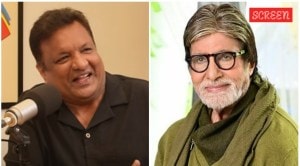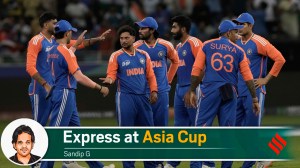‘I ask myself what exactly I want to do with dance. I want to reinvent, repossess it’
• We are in this extraordinary setting, the Natraja Temple at Chidambram in Tamil Nadu. Lord Natraja is called the Lord of Dance. He is...

• We are in this extraordinary setting, the Natraja Temple at Chidambram in Tamil Nadu. Lord Natraja is called the Lord of Dance. He is the inspiration for lot of Indian classical dances including Bharatnatyam and my guest today is Malvika Sarukkai, one the finest practitioners of that very fine art. A perfect setting for a tutorial on Bharatnatyam.
I don’t know if it’s a tutorial on Bharatnatyam but it’s definitely a place which inspires dance. Because I think spaces inspire. I believe it’s the temples that dance began and grew from. The place and the sheer expanse of space around one, fills one. I sometimes feel that when you go into a crowded room, it disturbs you in a way. Temples with their architecture — this is my personal feeling, we come to a place and feel the space — sort of expand around you. It makes you aware of something else too. Like a zen garden. The silence here seems to fill space. The dancer has to be aware of it. In a very detailed sense. In a very perceptive way. But I think dance is really dancing with space.
• What’s on your mind when you are dancing? Where does the inspiration come from? Creativity, spirituality?
With Indian dance space and time are the two factors that matter. And I think it’s really an alignment, this silence around you. Because in India one is always working on the opposites. You might think that dance is sound and melody and music, but I think that what the dancer is inside deeply aware of is silence.
• But does it come from God? This has been a home of Lord Shiva and his happy tandava, the Ananda tandava. Do you draw inspiration from God, spirituality?
Definitely, because Indian dance was inspired by myths, legends, the Puranas and the epics. And iconography. Here we have all the dancers and musicians playing, performing together. I think it celebrates life. In India temples are for the sacred and the secular and there is a wonderful mix of both here. We have the sacred within and the secular outside. It gives a kind of balance to the world. It isn’t all about austerity, but the livingness of life. The spiritual life.
• Does any other faith celebrate dance as much as ancient Hinduism?
Dance became a part of worship, it became prayer. It’s fortunate to get permission here to dance before the deity. But what is beautiful is no one knows who you are while you are dancing at the temple. You become completely anonymous. You can just stand in front and dance. Then dance takes on a completely different dimension. I danced here some years ago and people in front of me were offering prayers. The archana was going on. It gives you some energy within.
• Yet it took some doing to get permission to perform here. I think the British prohibited it.
British did a lot of things. The arts went through quite a decline. But it’s the sheer resilience of this country, the philosophy. I sometimes ask myself what exactly I want to do with dance. I want to reinvent, repossess it. Dance is not really the “ancient form”. People like to put it as something ancient. For me it is a language. A very evocative, very magnificent language that we speak through the body and gestures. It is essentially the energy of communication. Particularly the face, eyes, lips. It’s not only about expression but about the whole body. It’s a fabulous feeling. You struggle in the beginning as a student for the first ten years to get these expressions across. And this happens slowly.
• But you didn’t struggle much. You performed first at the age of 11 and danced at the Queen Elizabeth Hall, London, when you were 21. You were the youngest Indian to perform there.
I think I did. Dance happens. I don’t want to mystify the answer. I want to communicate and share it with my audience. And share the experience of dance. I don’t want to get my art across to people as an ancient, mysterious form. Rather I would take it as a language in the present tense. It has another dynamic to it.
• You talk about resilience in Indian society to evolve and carry on. It’s something that intrigues me, with such a great economic boom going on — India has seen economic growth that it hasn’t seen for centuries. India is being taken seriously around the world. Nobody internationally wants to hear anything bad about India anymore. People are even dismissing terrorism as something that happens everywhere. Yet we don’t see a cultural renaissance happening in the country. Why?
As a classical dancer, I think that classical arts really need to be supported for a renaissance. It cannot be on just one’s own faith, the vision, blaze or fire in you. It has to be supported constantly. I would like the corporate world to come forward and help to make it a truly meaningful, real renaissance.
• But why should the corporate world support unless there is something in it for them? We saw Zubin Mehta’s Munich Orchestra performing in India recently. The top five German companies sponsored the event because they support the cause of promoting German culture. Why not Indian corporates then?
I think one really has to understand the value of Indian classical arts for that. One has to be aware of how much the classical arts enrich our life. There is much to be derived from them. I do lecture demonstrations for the corporate world. One couldn’t have done this, say, five years ago. There is an interest for classical arts now. But it would be wonderful if people come in to support the arts financially.
• Is there more that the artistes can do to make the arts more profitable and productive. Pour some economics into art?
It’s a question of presentation. There is a large audience for classical arts but they are not well targeted. People of various age groups turn up for my performances. They say that they were not aware of the fact that classical dance is so communicative or evocative. I like such responses.
• I think there is a cultural renaissance in India but it is more to do with Bollywood and popular music. Events like ‘Indian Idol’ and other such shows.
I wish I could change this. I think they should give classical artistes a chance. There is so much to be done, experienced and discovered. And a great renaissance is possible. You have to explore the classical arts and expand its canvas.
• Many intellectuals in Bengal believe that what they call “apsanskriti” or lowly culture is subsuming the classical culture. What do you have to say about it?
It’s right. The classical arts have to go against a very strong stream to find their space. I believe the space is available but it has to be discovered.
• That space was there in the past. Look at people like Vyjayanthimala, Hema Malini, Waheeda Rehman. They were great classical dancers and they brought the classical forms to Hindi cinema. It promoted the dance forms. Why don’t we see you doing the same?
I got some offers some time ago. But I was more involved with the classical idiom. That was a different era when Vyjayanthimala danced. The classical had put some sort of flow into commercial cinema. Nowadays the dances have changed so much. Bollywood’s changed. Classical dance has to hold its own in its own space.
• Is there any kind of dance you would like to do in Bollywood?
I like good dancing wherever. No matter who is dancing. When my students don’t get a particular movement right, I tell them to think of Shahrukh Khan. I think he really has a great sense of discipline and energy to his movement.
• Among the women? Don’t say Shilpa Shetty.
No, not Shilpa Shetty. I think Madhuri Dixit. She has a very graceful style.
• Are you fond of Prabhudeva?
No, I have my reservations. But as I said, as far as dancing is about spirit and energy, I would be inspired by dance from any part of the world. It could be Fred Astaire.
• Do you think the moral policing business in your state will affect culture? Are you paying much attention to it?
It will. Because in the cultural space you do need to have a certain freedom. Only then can one grow. We have to have the freedom to express ourselves. But there are also definitions which have to be taken care of. So I think there is a balance between freedom and definitions.
• What about problems like the Khushboo controversy?
She is a celebrity. She might have said it with a different intent. But things can get focused in different ways. It’s a problem.
• But not many people from the creative community in Tamil Nadu rallied to her defence as much as they should have. The creative community here is strong and respected. Yet why not?
I don’t know whether it is the problem of south or north but people play safe. That’s part of the world we live in.
• Are you the type to play safe?
I play safe with my dancing.
• Our literature is loaded with erotica, and dance forms and music are much more spiritual. Is there a contradiction? How do you make the two converge?
We can’t say that all sahitya is erotica and all dance is spiritual.
• But erotica is a strong strand.
I’d use the word sensual. It’s closer to dance. But arts are really seen at different levels, whether it’s sahitya or dance. But it’s finding that level. In dance you have the sacred and the sensual. You could hold both. But it’s very important to look at literature and find whether it has the sensual or is falling into erotica. I think erotica is difficult with the classical arts but sensuality isn’t. And one is searching for this connection.
• Can you give an example through a short lecture demonstration?
(Doing abhinaya.) If you have some particular glances like these — bhava and body language which reflect more of physical yearning — it translates the sensual, the physical, the outer. With a typical nayika, say Radha, the focus would shift. There is a deeper feeling involved within the heart. It’s just not a physical embrace but a calling for a seating inside the heart, inside the self. The saint poets have sung beautifully with spirituality and sensuality. It takes years to even touch these aspects to the core, to come close to that vision of what it is that the poets spoke about.
• Critics say that you perform the Radha-Krishna act very remarkably. They say that unless one gets it right one can make baby Krishna look really ridiculous, as the critics put it. Or let’s say less sophisticated. How do you make it right?
Once I was dancing in this little village in Mahua, Gujarat. There was chulah-bandh (as in no cooking), the village had shut shop. Men were sitting on one side, women on the other with covered faces. Very conservative people. After presenting a few items, I performed a piece in Tamil which talked of Baby Krishna. I noticed the women were looking at me very intently. I was showing the beauty of Krishna. In one of the bhavas I posed as if I have an image of Krishna on my hand. I gesticulated through dance, as if asking, do you see him as I see him in my hands? They all nodded spontaneously. I was not speaking at all but we built up a conversation with my bhavas. They saw what I saw. This is the greatness of this art form. It helps you envision in front of your eyes.
• I can’t let you go without asking you one more question. You are a fabulous personality. So wonderfully talented, beautiful. Such a fine mind. A huge fan club. Why this single splendour?
I think for dance you give so many essential years to the art. Call it temperament, life, destiny.
• Unlike in other professions you don’t find male contemporaries. Dance, I think, is much more a single gender profession. Doctors find doctors. Journalists find journalists unfortunately. Why the singular glory?
(Laughs) I think dance students find dance students. It’s natural to do that when people are working together. But here I think I learnt singularly. It’s just been life itself.
• So many people watching you, a big fan following, you might find someone suitable.
Let’s see. As of now I am liking the single splendour.
Photos



- 01
- 02
- 03
- 04
- 05




























